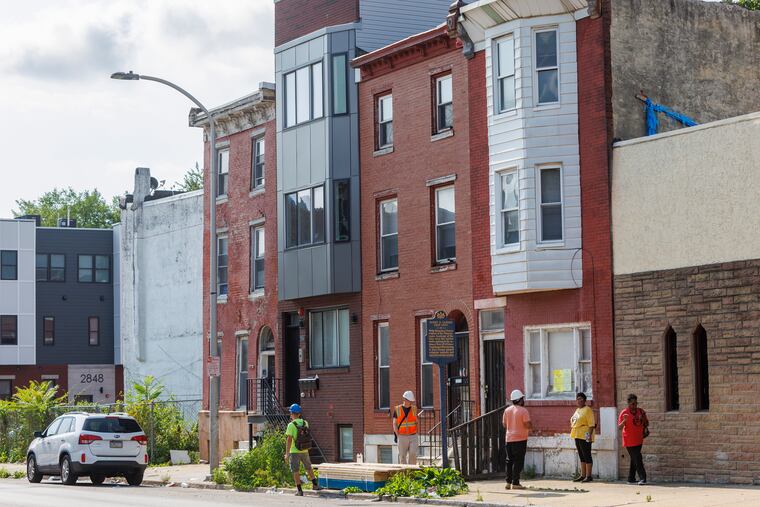New report from the Friends of the Tanner House shows a year of community engagement as Black heritage revitalization projects gain new attention
Friends of the Tanner House reports on ways to serve the community.

The Friends of the Tanner House has published a report about its yearlong project of engaging with the community on how ordinary residents might influence future programs and activities at the Tanner House once it is revitalized.
Located at 2908 W. Diamond St. in the Strawberry Mansion section of North Philadelphia, the Tanner House was the childhood home of internationally acclaimed artist Henry Ossawa Tanner and his extraordinarily accomplished family members.
In 2021, however, the city declared the house could be demolished because it was unsafe. The Inquirer first reported on the dangerous conditions at the house, which is a National Historic Landmark.
The Friends of the Tanner House (FOTH) then organized and launched a crowdfunding campaign to raise money for emergency stabilization repairs in February 2022.
The report, “Annunciating a Community Cultural Platform with Holistic Preservation,” discusses how the FOTH reached out to various community organizations and sought ideas from community residents in the neighborhood surrounding the Tanner House.
The project was funded by a $150,000 Mellon Foundation Humanities-in-Place grant to the FOTH and the Center for the Preservation of Civil Rights Sites at the University of Pennsylvania Weitzman School of Design.
» READ MORE: Once ‘the center of the Black intellectual community in Philadelphia,’ the Henry O. Tanner House could be demolished
The grant “allowed us the opportunity to build grounded awareness for our dream of revitalizing the Henry Ossawa Tanner House and making it a distinctive community-accessible cultural asset reflective of gifts and brilliance we witnessed in the Black cultural ecosystem of North Philadelphia,” said Christopher R. Rogers, co-coordinator of the FOTH.
‘For love to thrive in our neighborhood ...’
From May 2023 through June 2024, the FOTH sponsored projects led by either its artist-in-residence, Qiaira Riley, or other community partners, including:
“The People’s Dispensary,” a workshop on holistic healing inspired by the life of Tanner’s sister, Halle Tanner Dillon Johnson, a medical doctor who started a nursing school at Tuskegee Institute.
“Ceramic Altar Building,” a workshop inspired by the artist’s parents, Sarah Elizabeth Miller Tanner and Bishop Benjamin Tucker Tanner of the African Methodist Episcopal (AME) Church, about the role of religion and spirituality in fights for freedom. Tanner’s mother fled enslavement on the Underground Railroad as a child, and Tanner’s father helped found freedmen’s schools for formerly enslaved Black people.
A community cleanup day organized by the FOTH, the Blues Babe Foundation, and Tree House Books, which focused on cleaning up the 2900 block of West Diamond Street. Tree House Books donated books to children, and a luncheon at the Blues Babe Foundation followed the event.
Community surveys asked people to list “What activities should bring people together?” and “What histories should we learn about as a community?”
Among the answers about activities were: storytelling, block parties, sports, and art. The histories listed in one survey were: “The true history of our people,” “Queer histories,” “Organizing histories,” and “Neighborhood histories.”
The FOTH also connected with 30 organizations when it launched its Community Partner Network.
The importance of preservation
Currently, a second phase of stabilization work is underway. Rogers said this phase, to secure a rear wall, is needed before FOTH can go forward with the design-development planning necessary for its full revitalization. He said he would love to have that design plan ready by 2026, when there will be attention on Philadelphia for the 250th anniversary of the Declaration of Independence.
Tonnetta Graham, president of the Strawberry Mansion CDC, whose organization is working to revitalize the John Coltrane House, said it is important for community groups to work together.
“We are excited about having an opportunity to have another space that we can call our own,” Graham said. “The synergy around trying to get the Coltrane House, the Dox Thrash House, and the Tanner House [revitalized] has been building. It’s important of us to be able to share ideas.”
For Amber N. Wiley, who was the director of the Center for the Preservation of Civil Rights Sites during the last year, the work of the FOTH has been remarkable.
Wiley said that for most people, the history of historic preservation work has been to focus on the building itself, or on the remarkable contributions of a single individual.
But the focus of the Tanner House project has been to seek out how the house will meet the needs of the community in the future. And it is also recommending that the historical designation be changed to include the Tanner family, not only the artist.
“Sometimes it’s all about the glass and the brick and the wood and the windows,” Wiley said. “How will the person access this? How will the person feel in this space? For me, it was important to understand the societal influences and underpinning the history underneath.”
“For me, it was important to understand the societal influences and underpinning the history underneath.”
Tanner’s father, the Rev. Benjamin Tucker Tanner, moved his family to Philadelphia when he became editor of the Christian Recorder, the AME church newspaper that published national political news in addition to church news. Benjamin Tanner bought the house on Diamond Street in 1872, when the artist was 13 years old. Benjamin Tanner was elected a bishop in the AME church in 1888.
On Tuesday night, the Preservation Alliance for Greater Philadelphia is presenting a panel discussion called “Restoring Black Heritage Sites: Challenges and Opportunities” that will feature Rogers of the FOTH; Jillian Pirtle, CEO of the National Marian Anderson Museum & Historical Society; and Janice Sykes-Ross, executive director of the Paul Robeson House & Museum.
The discussion will take place from 6 to 8 p.m. Tuesday at the Cosmopolitan Club, 1616 Latimer St., Philadelphia. It is part of the Preservation Alliance’s Fall Speaker Series: Preserving Philadelphia. Preregistration is required.